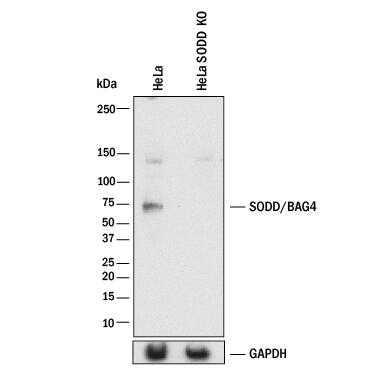Mouse/Rat SODD/BAG4 Antibody
R&D Systems, part of Bio-Techne | Catalog # AF4349

Key Product Details
Validated by
Species Reactivity
Applications
Label
Antibody Source
Product Specifications
Immunogen
Met1-Leu457
Accession # Q8CI61
Specificity
Clonality
Host
Isotype
Scientific Data Images for Mouse/Rat SODD/BAG4 Antibody
Detection of Mouse/Rat SODD/BAG4 by Western Blot.
Western blot shows lysates of A20 mouse B cell lymphoma cell line, CH-1 mouse B cell lymphoma cell line, and NRK rat normal kidney cell line. PVDF membrane was probed with 1 µg/mL of Mouse/Rat SODD/BAG4 Antigen Affinity-purified Polyclonal Antibody (Catalog # AF4349) followed by HRP-conjugated Anti-Goat IgG Secondary Antibody (HAF109). Specific bands were detected for SODD/BAG4 at approximately 65 - 70 kDa (as indicated). This experiment was conducted under reducing conditions and using Immunoblot Buffer Group 2.Western Blot Shows Human SODD/BAG4 Specificity by Using Knockout Cell Line.
Western blot shows lysates of HeLa human cervical epithelial carcinoma parental cell line and SODD/BAG4 knockout HeLa cell line (KO). PVDF membrane was probed with 1 µg/mL of Goat Anti-Mouse/Rat SODD/BAG4 Antigen Affinity-purified Polyclonal Antibody (Catalog # AF4349) followed by HRP-conjugated Anti-Goat IgG Secondary Antibody (Catalog # HAF017). A specific band was detected for SODD/BAG4 at approximately 72 kDa (as indicated) in the parental HeLa cell line, but is not detectable in knockout HeLa cell line. GAPDH (Catalog # AF5718) is shown as a loading control. This experiment was conducted under reducing conditions and using Immunoblot Buffer Group 1.Applications for Mouse/Rat SODD/BAG4 Antibody
Knockout Validated
Western Blot
Sample: A20 mouse B cell lymphoma cell line, CH-1 mouse B cell lymphoma cell line, and rat kidney tissue
Formulation, Preparation, and Storage
Purification
Reconstitution
Formulation
Shipping
Stability & Storage
- 12 months from date of receipt, -20 to -70 °C as supplied.
- 1 month, 2 to 8 °C under sterile conditions after reconstitution.
- 6 months, -20 to -70 °C under sterile conditions after reconstitution.
Background: SODD/BAG4
Tumor necrosis factor receptor-1 (TNF-R1) and other TNF receptor superfamily members, such as DR3, contain intracellular death domains (DD) and are capable of initiating apoptosis when activated by their ligands. Silencer of Death Domains (SODD) was identified as being involved in the cellular mechanism to protect against ligand-independent signaling by TNF-R1 and other DD receptors. SODD, also known as Bcl-2-Associated Athanogene 4 (BAG4), is a 457 amino acid (aa), anti‑apoptotic protein that functions through interactions with a variety of proteins including BCL-2, Raf-protein kinase, steroid hormone receptors, growth factor receptors, and members of the heat shock protein 70 kDa family. SODD is a ubiquitously expressed, cytoplasmic protein that contains a C terminal BAG domain that can bind and inhibit the chaperone activity of Hsc70/Hsp70. The association of SODD with the DD of TNF-R1 prevents constitutive activation of the TNF-R1 signaling pathway. Binding of TNF to TNF-R1 releases SODD and permits adapter molecules such as TRADD to associate with TNF-R1 leading to the activation of TNF signaling pathways such as apoptosis and NF kappaB activation.
Long Name
Alternate Names
Gene Symbol
UniProt
Additional SODD/BAG4 Products
Product Documents for Mouse/Rat SODD/BAG4 Antibody
Product Specific Notices for Mouse/Rat SODD/BAG4 Antibody
For research use only

